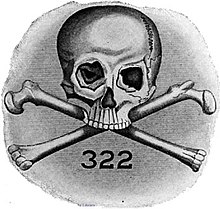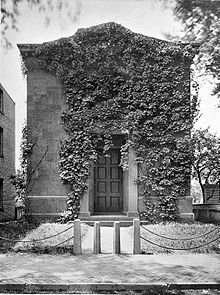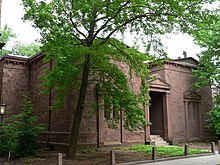
Prescott Sheldon Bush Sr. was an American banker and Republican Party politician. After working as a Wall Street executive investment banker, he represented Connecticut in the United States Senate from 1952 to 1963.A member of the Bush family, he was the father of President George H. W. Bush, and the paternal grandfather of President George W. Bush and Florida Governor Jeb Bush.

Yale College is the undergraduate college of Yale University. Founded in 1701, it is the original school of the university. Although other Yale schools were founded as early as 1810, all of Yale was officially known as Yale College until 1887, when its schools were confederated and the institution was renamed Yale University. It is ranked as one of the top colleges in the United States.

The Scroll and Key Society is a secret society, founded in 1842 at Yale University, in New Haven, Connecticut. It is one of the oldest Yale secret societies and reputedly the wealthiest. The society is one of the reputed "Big Three" societies at Yale, along with Skull and Bones and Wolf's Head. Each spring the society admits fifteen rising seniors to participate in its activities and carry on its traditions.
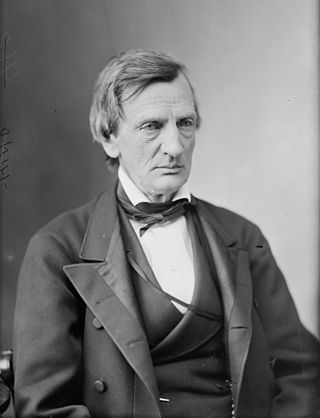
William Maxwell Evarts was an American lawyer and statesman from New York who served as U.S. Secretary of State, U.S. Attorney General and U.S. Senator from New York. He was renowned for his skills as a litigator and was involved in three of the most important causes of American political jurisprudence in his day: the impeachment of a president, the Geneva arbitration and the contests before the electoral commission to settle the presidential election of 1876.

William Henry Donaldson was the 27th Chairman of the U.S. Securities and Exchange Commission (SEC), serving from February 2003 to June 2005. He served as Under Secretary of State for International Security Affairs in the Nixon Administration, as a special adviser to Vice President Nelson Rockefeller, Chairman and CEO of the New York Stock Exchange, and Chairman, President and CEO of Aetna. Donaldson founded Donaldson, Lufkin & Jenrette.

Elihu Club or Elihu is the fourth oldest senior society at Yale University, New Haven, CT. It was founded in 1903 and takes its name from Elihu Yale.

Wolf's Head Society is a senior society at Yale University in New Haven, Connecticut. The society is one of the reputed "Big Three" societies at Yale, along with Skull and Bones and Scroll and Key. Active undergraduate membership is elected annually with sixteen Yale University students, typically rising seniors. Honorary members are elected.

George Herbert Walker Jr. was an American businessman and an uncle of President George H. W. Bush.
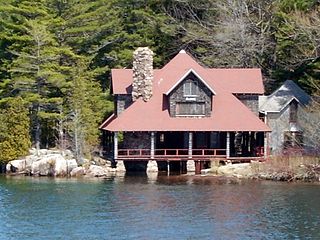
Deer Island is one of the American Thousand Islands. It lies between mainland Canada and United States, within the Saint Lawrence River, in the Town of Alexandria, close to Alexandria Bay, New York. It is owned entirely by the Russell Trust Association and is used as a Skull and Bones retreat.
Manuscript Society is a senior society at Yale University in New Haven, Connecticut. It is reputedly the arts and letters society at Yale.
There are many collegiate secret societies in North America. They vary greatly in their level of secrecy and the degree of independence from their universities. A collegiate secret society makes a significant effort to keep affairs, membership rolls, signs of recognition, initiation, or other aspects secret from the public.

Alexandra Robbins is a journalist, lecturer, and author. Her books focus on young adults, education, and modern college life. Five of her books have been New York Times Bestsellers.

Linonia is a literary and debating society founded in 1753 at Yale University. It is the university's second-oldest secret society.

Roy Leslie Austin is a former United States Ambassador to Trinidad and Tobago from December 2001 to December 2009.
Mace and Chain is an "Ancient Eight" society, or one of the eight landed secret societies, at Yale University. It was founded in 1956 with the mission of providing fifteen rising seniors with the traditional senior society experience in a freer, more modern setting. Mace and Chain's tomb, a centuries-old colonial structure owned by the society, boasts various military artifacts, Revolutionary War documents, and a purposefully open appearance. As is tradition for Yale secret societies, the tomb is accessible only to current members and alumni.
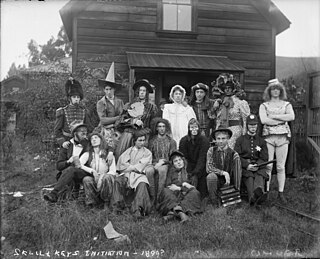
Skull & Keys was a men's honor society at the University of California, Berkeley in Berkeley, California. The organization was started by Theta Nu Epsilon. Skull & Keys was the first of several collegiate secret societies that formed from the fraternity system at Berkeley.
Alexander B. Ellis III, formerly an executive with alternative energy companies, and now a partner in the venture-capital firm Rockport Capital Partners. He is a nephew of former President of the United States George H. W. Bush and a first cousin of former President George W. Bush and the former Governor of Florida John Ellis "Jeb" Bush.
Owl and Key is a student organization at the University of Utah that is a cross between a senior society and an honor society.

Spade and Grave (S&G), also called S.L.M., is a senior secret society at Yale University in New Haven, Connecticut. Founded in 1864, it is one of Yale's oldest societies.
